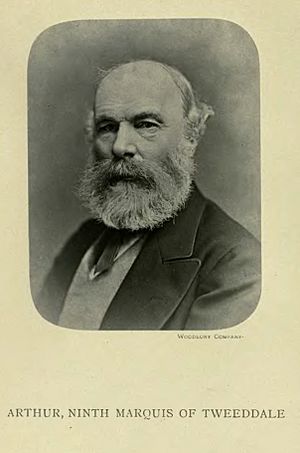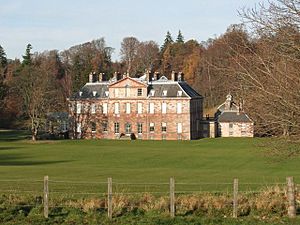Arthur Hay, 9th Marquess of Tweeddale facts for kids
Quick facts for kids
The Most Honourable
The Marquess of Tweeddale
|
|
|---|---|
 |
|
| Born |
Arthur Hay
9 November 1824 Yester House, Gifford, East Lothian, Scotland
|
| Died | 29 December 1878 (aged 54) Chislehurst, London, England
|
| Other names | Lord Arthur Hay, Viscount Walden |
| Education | University of Leipzig, University of Geneva |
| Spouse(s) |
Helene Kilmansegge
(m. 1857; died 1871)Julia Stewart-Mackenzie
(m. 1873) |
| Parent(s) | George Hay, 8th Marquess of Tweeddale Lady Susan Montagu |
| Scientific career | |
| Fields | Ornithologist, soldier |
| Institutions | Zoological Society of London (President 1868–1878) |
Colonel Arthur Hay, 9th Marquess of Tweeddale (born November 9, 1824 – died December 29, 1878) was a Scottish soldier and a well-known expert on birds, also called an ornithologist. Before 1862, he was known as Lord Arthur Hay. From 1862 to 1876, people called him Viscount Walden. He was a respected member of several important societies, including the Royal Society and the Zoological Society of London.
Contents
Arthur Hay's Life Story

Arthur Hay was born at Yester House in Scotland, near a town called Gifford. His father was General Sir George Hay, 8th Marquess of Tweeddale, and his mother was Lady Susan Montague. Arthur went to university in two different countries: Leipzig in Germany and Geneva in Switzerland.
Becoming a Soldier
In 1841, Arthur Hay joined the British Army. He became a high-ranking officer, a Colonel, in a famous group called the Grenadier Guards. He served as a soldier in important places like India and during the Crimean War. In 1876, he took over his father's title and became the Marquess of Tweeddale.
He bought his first military rank, a lieutenancy, in the Grenadier Guards in 1841. He then bought a captaincy in 1846. He was promoted to lieutenant-colonel in 1854 and then to Colonel in 1860. Later, in 1866, he moved to a different army group, the 17th Lancers.
His Love for Birds
Arthur Hay was very passionate about birds. He became the president of the Zoological Society of London in 1868. He had his own large collection of birds, insects, reptiles, and mammals. To add to his collection, he hired a traveler named Carl Bock. Carl Bock traveled to places in Maritime Southeast Asia to find and collect new animal specimens for Arthur Hay.
Arthur Hay himself described about 40 new species of birds that Carl Bock collected. Because of his important work in science, he was chosen to be a Fellow of the Royal Society in 1871. This is a very high honor for scientists.
After he passed away, his nephew, Captain Robert George Wardlaw-Ramsay, published all of Arthur Hay's writings about birds in 1881. These writings are still used today, and his name "Walden" is often used in scientific lists of animal species.
His Later Years
Lord Tweeddale died at his home in Chislehurst, London, on December 28, 1878. He did not have any children. So, his brother, William, became the next Marquess of Tweeddale.
Arthur Hay's Family
Arthur Hay was married two times. His first wife was Helene Kilmansegge. They married in 1857, and she passed away in 1871. He then married Julia Mackenzie of Seaforth in 1873. Julia was the daughter of Lieutenant-Colonel Keith William Stewart-Mackenzie. After Arthur Hay's death, Julia married two more times, but she did not have any children with any of her husbands.

